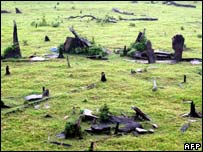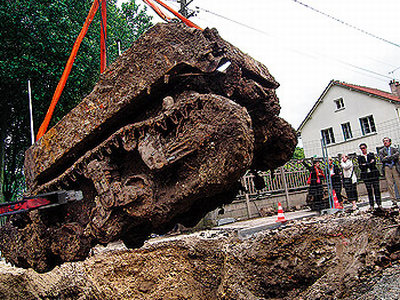Farmers who inadvertently moved their borders and expanded their territory became a hot topic

A farmer living in Belgium moved a stone saying that it was 'obstructing the course of the tractor', which changed the border between France and Belgium, expanding the land of Belgium while shrinking the land of France. I understand.
Le village de Bousignies-sur-Roc est plus petit depuis qu'un agriculteur belge a déplacé la borne frontière
Pour pouvoir passer avec son tracteur, un agriculteur belge a déplacé la frontière française --Edition du soir Ouest-France --03/05/2021
https://www.ouest-france.fr/leditiondusoir/2021-05-03/pour-pouvoir-passer-avec-son-tracteur-un-agriculteur-belge-a-deplace-la-frontiere-francaise-265ec799- 7c56-4afe-9dd3-88edb058a0b9
Farmer moves border stone for tractor – and makes Belgium bigger | Belgium | The Guardian
https://www.theguardian.com/world/2021/may/04/farmer-moves-border-stone-for-tractor-and-makes-belgium-bigger
The place where the stone in question was located is as follows. It is the border between two villages, Bousignies-sur-Rock (France) and Erquelinnes (Belgium). The place was originally French, but was annexed to the Netherlands at the Congress of Vienna after Napoleon was defeated at the Battle of Waterloo in 1815. Later, when the Kortrijk Treaty was signed in 1820, the border between France and the Netherlands was established, and after the independence of the Kingdom of Belgium in 1830, it was inherited as the border between Belgium and France.

The stones moved by Belgian farmers set this border. An amateur historian with a vintage map was strolling near the border village of Erquelinnes in April 2021 and noticed that the stone had moved about 2.29 meters. The situation was discovered when a historian contacted the city after hearing from the landowner and feeling that the farmer had violated the Kortrijk Treaty.
This is the stone. It seems that the farmer moved the position of the fence installed by the farmer as the stone moved.
Ricordando
#NapoleoneBonaparte .
Un agricoltore di Erquelinnes #Belgio stanco di dover litigare ogni giorno con una pietra che intralciava il suo trattore l'ha spostata ridisegnando i confini stabiliti dopo #Waterloo , rimpicciolendo la #Francia .
Il sindaco del paesino ... (1/3) pic.twitter.com/Znrk5kKcXx — Sandro Di Domenico (@SandorDD) May 5, 2021
At the time when the border was set, GPS technology did not exist, so it seems that a number of such stones were placed to set the border.

David Lavaux, the mayor of the village of Erquelinnes, was amused by the inadvertent expansion of his territory, but told farmers that 'it's not best to create diplomatic problems' and reposition the stones. Pointed out to. 'We are not interested in expanding the territory of the village. He made Belgium bigger and France smaller, but this is not a good idea.' 'I am happy that the territory of the village has grown. , The mayor of the village of Bousignies-sur-Rock in France wouldn't be, 'Lavaux commented on the French television show TF1.
The man in the image is Mr. Lavaux.
David Lavaux ha detto: 'Ora il Belgio è più grande, e la Francia più piccola e non è una buona idea.
— Sandro Di Domenico (@SandorDD) May 5, 2021
All'inizio ero contento perché il villaggio era cresciuto, ma la mia collega di Bousignies-sur-Roc non la pensa allo stesso modo.
Se l'agricoltore è d'accordo ... (2/3) pic.twitter.com/geQeVabJnd
There is no problem if the farmer returns the position of the stone immediately. However, under the Kortrijk Treaty, a committee of representatives from France and Belgium must be summoned to discuss borders, which can lead to diplomatic issues if farmers do not return the stones. Farmers may also be subject to criminal liability.
Related Posts:
in Note, Posted by darkhorse_log







